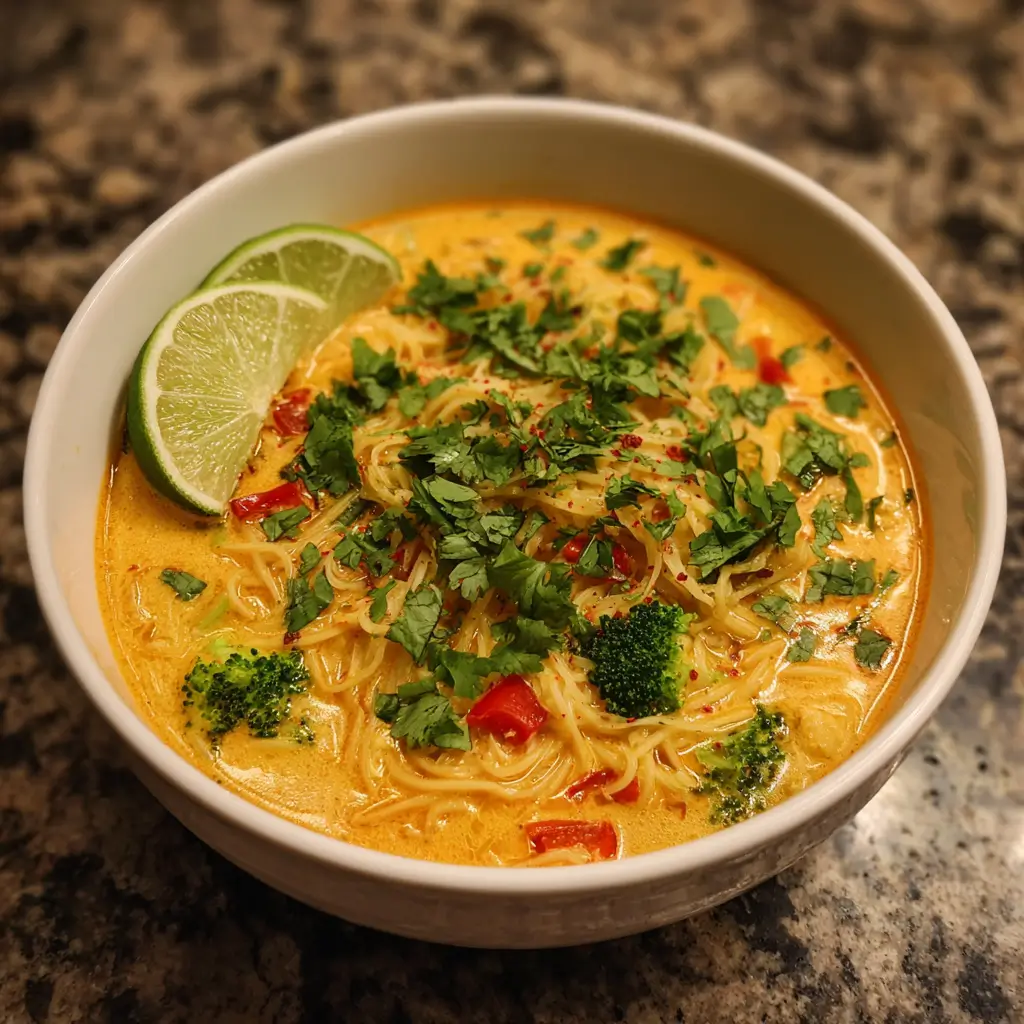Thai Coconut Curry Soup
Introduction
Thai Coconut Curry Soup, also known as Tom Kha Gai (when made with chicken) or Tom Kha Kai (with egg), is a beloved dish in Thai cuisine that perfectly balances creamy coconut milk, aromatic spices, and a touch of heat. It’s known for its rich, velvety texture and its complex flavor profile that combines sweet, sour, salty, and spicy notes in one harmonious bowl. This soup is a staple in Thai households and restaurants alike, offering warmth and comfort with every spoonful. Whether served as a starter or a main dish, Thai Coconut Curry Soup is a culinary masterpiece that showcases the depth and sophistication of Thai cooking.
The History
Thai Coconut Curry Soup has its roots in traditional Thai cooking, where coconut milk has long been a staple ingredient. The name “Tom Kha” translates to “boiled spicy and sour,” while “Gai” means chicken—though the soup can be made with various proteins or even as a vegetarian dish. It is believed to have evolved from other Thai soups like Tom Yum, which is clear and broth-based. Over time, cooks began adding coconut milk to create a creamier, richer version that is now widely recognized and enjoyed around the world. The soup’s popularity has grown beyond Thailand, becoming a favorite in Thai restaurants across the globe.
Ingredients Breakdown
The key to a great Thai Coconut Curry Soup lies in the balance and freshness of its ingredients. Here’s a breakdown of the essential components:
- Coconut Milk: Provides the creamy base and balances the spice and acidity.
- Galangal: A root similar to ginger, with a sharper, citrusy flavor unique to Thai soups.
- Lemongrass: Adds a bright, lemony aroma and flavor.
- Kaffir Lime Leaves: Contribute a distinct citrus fragrance and are essential for authentic flavor.
- Shallots or Onions: Add sweetness and depth to the broth.
- Bird’s Eye Chili: Brings the signature heat; quantity can be adjusted based on preference.
- Fish Sauce: Offers a salty, umami-rich backbone to the soup.
- Lime Juice: Adds a tangy, sour finish that brightens the entire dish.
- Protein: Commonly chicken, shrimp, tofu, or egg.
- Mushrooms: Often straw or shiitake mushrooms for added texture and earthiness.
Step-by-Step Recipe
- Prepare the Aromatics: Bruise the lemongrass and slice the galangal. Tear the kaffir lime leaves to release their aroma.
- Simmer the Broth: In a pot, combine coconut milk, galangal, lemongrass, and kaffir lime leaves. Bring to a gentle simmer.
- Add Vegetables and Protein: Add sliced shallots, mushrooms, and your chosen protein. Cook until the protein is fully done.
- Season: Stir in fish sauce and bird’s eye chilies. Taste and adjust salt and spice levels.
- Finish with Lime: Squeeze in fresh lime juice just before serving to preserve its brightness.
- Garnish and Serve: Ladle into bowls and garnish with fresh cilantro or Thai basil leaves.
Tips
- Use full-fat coconut milk for a richer, creamier texture.
- Don’t skip the kaffir lime leaves—they add a flavor that can’t be replicated with lime zest or juice alone.
- Galangal and lemongrass can be found in most Asian markets or online; they can be frozen for future use.
- If you can’t find galangal, ginger can be used as a substitute, though the flavor will differ slightly.
- Simmer the aromatics gently to infuse the broth without boiling off delicate flavors.
- Add lime juice just before serving to preserve its fresh tang.
Variations and Customizations
Thai Coconut Curry Soup is incredibly versatile and can be customized to suit different tastes and dietary preferences:
- Vegetarian: Omit fish sauce and use soy sauce or tamari instead. Replace animal protein with tofu, eggplant, or mixed vegetables.
- Seafood: Use shrimp, squid, or mussels for a lighter, oceanic twist.
- Spice Level: Adjust the number of bird’s eye chilies to make it milder or spicier.
- Vegetable Additions: Add bell peppers, bamboo shoots, or baby corn for extra crunch and color.
- Broth Base: Some versions add chicken broth or vegetable stock to the coconut milk for a more complex base.
- Egg Version: Beat eggs and drizzle into the soup while stirring gently to create silky egg ribbons.
Health Considerations and Nutritional Value
Thai Coconut Curry Soup offers a range of nutrients depending on the ingredients used:
- Healthy Fats: Coconut milk provides medium-chain triglycerides (MCTs), which may support heart health in moderation.
- Protein: Chicken, shrimp, tofu, or eggs offer a good source of lean protein for muscle repair and satiety.
- Antioxidants: Lemongrass, galangal, and chilies contain antioxidants and anti-inflammatory compounds.
- Low Carb and Keto-Friendly: Naturally low in carbs, making it suitable for low-carb and ketogenic diets when served without rice.
- Watch Sodium: Fish sauce can be high in sodium—use in moderation or opt for low-sodium versions.
Ingredients
- 2 cans (13.5 oz each) full-fat coconut milk
- 2 stalks lemongrass, bruised and cut into 2-inch pieces
- 3-4 slices fresh galangal (or substitute ginger)
- 2-3 kaffir lime leaves, torn
- 1 shallot or small onion, sliced
- 2-3 bird’s eye chilies (adjust to taste)
- 1 cup sliced mushrooms (straw mushrooms or shiitake)
- 1 lb chicken breast or thighs, sliced (or substitute with shrimp, tofu, or egg)
- 2 tbsp fish sauce (or soy sauce for vegetarian)
- 1-2 limes, juiced
- Fresh cilantro or Thai basil for garnish
Directions
- In a large pot, combine coconut milk, lemongrass, galangal, and kaffir lime leaves. Bring to a gentle simmer over medium heat.
- Add sliced chicken (or other protein) and cook for 5–7 minutes until nearly cooked through.
- Add shallots, mushrooms, and chilies. Continue simmering for another 5 minutes or until the chicken is fully cooked.
- Stir in fish sauce and taste. Adjust seasoning as needed.
- Remove from heat and stir in fresh lime juice just before serving.
- Garnish with fresh cilantro or Thai basil before serving.
FAQ
- Can I make this soup ahead of time?
Yes, it can be refrigerated for up to 3 days. Reheat gently on the stove to avoid separating the coconut milk. - Can I freeze Thai Coconut Curry Soup?
Yes, it freezes well for up to 2 months. Thaw in the fridge and reheat slowly, adding a splash of water or broth if needed. - Is it supposed to be spicy?
Traditional versions have some heat, but you can control the spice level by adjusting the number of chilies. - Can I use light coconut milk?
You






